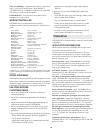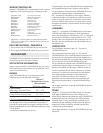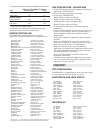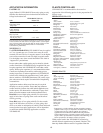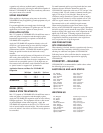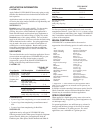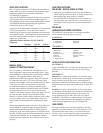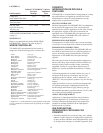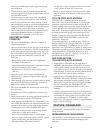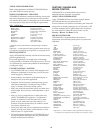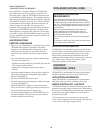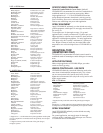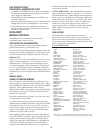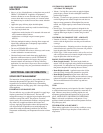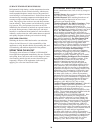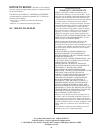
USE PRECAUTIONS
NON-CROP
•
Injury to or loss of desirable trees or other plants may result if
DuPont™ VELPAR® DF is applied or if equipment is
drained or flushed on or near desirable trees or other plants,
on areas where their roots may extend, or in locations where
the chemical may be washed or moved into contact with their
roots.
• Application spray drift may injure desirable plants.
• Poor weed and brush control may result from the following:
–Use on poorly drained sites
–Applications made when the soil is saturated with water and
rain is imminent within 24 hours.
–Applications to soils high in organic matter (greater
than 5%).
• Following mechanical cutting or clearing, allow stumps and
injured trees sufficient time to adequately resprout before
applying VELPAR® DF.
• Do not use VELPAR® DF on frozen soils.
• Do not use VELPAR® DF on lawns, driveways, tennis courts,
or other residential or recreational areas.
• Weed and brush control results from spring applications
depend on sufficient moisture to activate VELPAR® DF.
• Do not cut treated vegetation for forage or hay nor graze
domestic animals on treated areas for 60 days following
application. For rates above 8 lb per acre, do not cut treated
vegetation for forage or hay nor graze domestic animals for 1
year.
SPRAY DRIFT MANAGEMENT
The interaction of many equipment- and weather-related factors
determines the potential for spray drift. The applicator is
r
esponsible for consider
ing all these f
actors when making
application decisions. Avoiding spray drift is the responsibility
of the a
pplicator.
IMPOR
TANCE OF DROPLET SIZE
The most effective way to reduce drift potential is to apply large
droplets (greater than 150–200 microns). The best drift
management strategy is to apply the largest droplets that provide
sufficient coverage and control. The presence of sensitive
species nearby, the environmental conditions, and pest pressure
may affect how an applicator balances drift control and
coverage. Applying larger droplets reduces drift potential, but
will not prevent drift if applications are made improperly or
under unfavorable environmental conditions! See the Wind,
Temperature and Humidity, and Temperature Inversions sections
below.
CONTROLLING DROPLET SIZE
- GENERAL TECHNIQUES
• Volume - Use high flow rate nozzles to apply the highest
practical spray volume. Nozzles with higher rated flows
produce larger droplets.
• Pressure - Use the lower spray pressures recommended for the
n
ozzle. Higher pressure reduces droplet size and does not
i
mprove canopy penetration. When higher flow rates are
needed, use a higher-capacity nozzle instead of increasing
pressure.
• Nozzle Type - Use a nozzle type that is designed for the
intended application. With most nozzle types, narrower spray
angles produce larger droplets. Consider using low-drift
nozzles.
CONTROLLING DROPLET SIZE - AIRCRAFT
• Number of Nozzles - Use the minimum number of
nozzles with the highest flow rate that provide uniform
coverage.
• Nozzle Orientation - Orienting nozzles so that the spray is
emitted backwards, parallel to the airstream will produce
larger droplets than other orientations.
• Nozzle Type - Solid stream nozzles (such as disc and core
with swirl plate removed) oriented straight back produce
larger droplets than other nozzle types.
BOOM LENGTH AND HEIGHT
• Boom Length (aircraft) - The boom length should not
exceed 3/4 of the wing length, using shorter booms decreases
drift potential. For helicopters use a boom length and position
that prevents droplets from entering the rotor vortices.
• Boom Height (aircraft) - Application more than 10 feet
above the canopy increases the potential for spray drift.
•
Boom Height (ground) Setting the boom at the lowest
labeled height (if specified) which provides uniform coverage
reduces the exposure of droplets to evaporation and wind.
The boom should remain level with the crop and have
minimal bounce.
WIND
Dr
ift potential incr
eases at wind speeds of less than 3 mph (due
to variable direction and inversion potential) or more than 10
mph. However, many factors, including droplet size and
equipment type determine drift potential at any given wind
speed
.
A
V
OID GUSTY OR WINDLESS CONDITIONS.
Note: Local ter
r
ain can inf
luence wind patterns. Every
a
pplica
tor should be f
amiliar with local wind pa
tter
ns and ho
w
they effect spray drift.
TEMPERATURE AND HUMIDITY
W
hen making a
pplications in hot and dry conditions, set up
equipment to produce larger droplets to reduce effects of
evaporation.
ADDITIONAL USE INFORMATION
23



